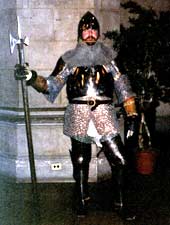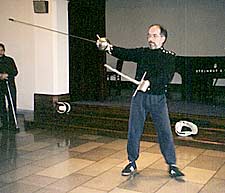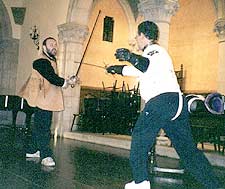Western Martial Arts Workshop 2001
Report by Ken Mondschein
 When
writing a report about the Third Annual Western Martial Arts Workshop,
one might as well begin by answering the obvious questions: "What
is a Western martial art?" and "What were the First and Second
Western Martial Arts Workshops?" When
writing a report about the Third Annual Western Martial Arts Workshop,
one might as well begin by answering the obvious questions: "What
is a Western martial art?" and "What were the First and Second
Western Martial Arts Workshops?"
Simply put, a Western martial art is one of the native fighting systems
developed in Europe and her colonies. It is an umbrella term that includes
unarmed arts such as French savate, Breton wrestling, and English boxing,
as well as arts using weapons, such as knives, sticks, and swords. Added
to these fighting arts that come down to us in a direct fashion are those
which scholars and practitioners have spent years in reconstructing from
available evidence, such as the armored fighting skills of the medieval
knight or the rapier fencing of the Renaissance.
The work that has been done in studying and resurrecting these "lost"
arts is quite astounding. Luckily, we do have some direct transmission,
as in the manner of the Japanese koryu, to work from, and the language,
pedagogical forms, and intent of the Western manuals are not as dissimilar
to our way of thinking as those of some Asian arts are. It was the intention
of the authors of these manuals to set out their art for future generations
in a plain, explicit way. The techniques, and more importantly, the devastating
principles behind their use, can thus be recovered and implemented with
a fair degree of accuracy. Such arts are not only cultural artifacts and
academic curiosities filling dusty volumes of scholarly rumination: they
are extremely relevant to today, and frighteningly effective in their
application.
 |
| Maestro Ramon Martinez of
the Martinez
Academy of Arms lectures on La Verdadera Destreza, the
Spanish school of rapier fence. |
The annual Western Martial Arts Workshop (or WMAW for short) is thus
more than just a martial arts seminar, but also something of an academic
conference. Simply put, it is the pre-eminent event in the small but tightly
knit, rabidly enthusiastic, and rapidly growing community of practitioners
of Western martial artists -- those hardy souls dedicated to both preserving
what comes down to us directly and recovering what does not. Beginning
as an informal get-together hosted by the Chicago Swordplay Guild in 1999,
the WMAW has grown enormously. Last year's WMAW, held in Toronto by the
Academy of European Medieval Martial Arts, was judged a great success,
and this year's was eagerly anticipated months in advance, as much a learning
opportunity as a chance to get together with old comrades-in-arms.
Undismayed by the tragic events of September 11, scores of attendees
from Canada, Italy, Australia, the U.K, and all across the United States
convened in New York City for the first WMAW of the new millennium. This
year's gathering was hosted from October 12th through 14th in the beautiful
neo-Gothic halls of Riverside Church by the Association
for Historical Fencing, one of the foremost groups dedicated
to the study and preserving of Western martial arts. It featured expert
instructors in arts ranging from Spanish knife-fighting, Italian cane,
classical fencing, and savate, to reconstructions of medieval systems
of swordsmanship and renaissance grappling. Being able to schedule so
many events and seminars was a feat of organization itself: at any time
during the three days, a hands-on demonstration or lecture in the main
auditorium ran concurrently with two three-hour-long master's classes
on the ninth and tenth floors. These master's classes enabled each participant
to taste a variety of different arts, as well as see what some of the
foremost researchers in the field were doing. However, since nobody, regardless
of their endurance, could attend every class, much of the material was
repeated later in the auditorium.
The seminars and events kicked off on Friday morning with a seminar on
proper body mechanics, bearing, and alignment in the Western martial arts,
conducted by the members of the International Masters-at-Arms Federation
(IMAF) who were in attendance. (The IMAF is a professional association
of teachers of European-heritage weapons.) This seminar started the weekend
off on the right foot, as it were, by emphasizing technique over brute
force, and emphasizing that, though times have changed, the basic biomechanical
principles of skillful weapons-handling have not.
To go into depth on each of the many excellent classes and lectures that
followed would be tedious both to write and to read, besides the impossibility
of doing justice to each instructor's superb presentation. Therefore,
a brief synopsis of each class will have to suffice.
To begin with the classes on reconstructed arts, Maestro Paul Macdonald
of Edinburgh, Scotland, ably assisted by Mr. Robert Brooks of Chillingham,
presented a well-received class on singlestick. This was a typically English
sport, quite popular in the nineteenth century, that involves fencing
with an ash stick until one player's head is split open. Ken Pfrenger,
a specialist in Celtic martial arts, gave instruction in both Irish stick-fighting
and Cornish wrestling. Similarly, Brad Waller's work on the Italian master
Marozzo's grappling techniques, set down in his manual of 1536, revealed
to those lucky enough to take his class a complete system of martial arts
rivaling any in the world for sophistication and effectiveness.
| |
A number of researchers, such as Ian Johnson, David Cvet, Brian
McIlmoyle, and Christian Tobler, also gave excellent presentations
on their reconstructions of medieval manuals. For those interested
in medieval European martial arts, Bob Charron's (seen here) precise
analysis of the medieval Italian master Fiore di Liberi, as well
as his mastery of Fiore's elegant, yet devastating, system of combat,
has proven a perennial favorite. |
 Rapier
fence is a subject of great interest to the Western martial arts community,
and WMAW attendees did not go home disappointed. William Wilson of Arizona
and Stephen Hand of the Stocatta
School of Defence in Australia (shown at the right with
Mark Rector) provided instruction on this subject, with Mr. Wilson concentrating
on the Italian master Fabris, and Mr. Hand on the art as it was practiced
in Shakespeare's time. Mr. Hand has gained quite a reputation for his
knowledge of Elizabethan fighting arts, and gave a wonderful demonstration
of Saviolo's rapier technique, as well as George Silver's typically English
system of sword and buckler. Rapier
fence is a subject of great interest to the Western martial arts community,
and WMAW attendees did not go home disappointed. William Wilson of Arizona
and Stephen Hand of the Stocatta
School of Defence in Australia (shown at the right with
Mark Rector) provided instruction on this subject, with Mr. Wilson concentrating
on the Italian master Fabris, and Mr. Hand on the art as it was practiced
in Shakespeare's time. Mr. Hand has gained quite a reputation for his
knowledge of Elizabethan fighting arts, and gave a wonderful demonstration
of Saviolo's rapier technique, as well as George Silver's typically English
system of sword and buckler.
 |
| J.
Christoph Amberger and an assistant demonstrate mensur technique. |
Though the reconstruction of ancient martial arts is a subject near and
dear to the hearts of the Western martial arts community, WMAW is no less
about resurrecting the past than it is about preserving that which has
been handed down for centuries. Particular standouts were a lecture and
demonstration of the history and practice of Schlager dueling, or mensur,
by Secret History of the Sword author Christoph Amberger. Mr. Amberger
proved as erudite in person as on paper, and many attendees were thankful
for a chance to finally meet the man behind the pen. James Loriega, author
of Sevillian Steel, also gave a well-attended and enthusiastically received
class and lecture on the navaja, or Andalusian folding knife. The depth
of knowledge, as well as the frighteningly effective and skilful technique,
exhibited by this otherwise unassuming gentleman astounded all the participants.
From Italy, Maestro Lorenzo Ravazzani and Maestro Cosimo Bruno gave impressive
classes and lectures on their areas of expertise, savate and cane fencing,
or la canne as they are practiced in Italy. While superficially resembling
Asian arts that also incorporate kicks and punches, the pragmatic, yet
elegant, approach found in Maestro Bruno's savate technique greatly impressed
the audience. None left without the impression that a skilled savateur
could hold his own against any proponent of the world's fighting arts.
Maestro Ravazzani took the lead in the class on can fighting, where he
and Maestro Bruni once again impressed students with their elegant, effective,
technique.
 Finally,
Maestro Ramon Martinez and Maestro Jeanette Acosta-Martinez, besides organizing
the event, also gave instruction in their particular areas of expertise.
These two maestri gave well-received lectures on the weapons and customs
of the formal duel of the 19th and early 20th centuries, the last era
in which gentlemen used sharp weapons in earnest to settle affairs of
honor. This, the cold reality of the duel, forms the basis of the fencing
technique taught in their school, the Martinez Academy of Arms in New
York City. Maestro Martinez also gave a well-received class in his reconstruction
of the much-legended but also much-misunderstood Spanish school of fence,
La Verdadera Destreza. Maestro Acosta-Martinez, for her part, taught a
master's class on the use of of the deceptively light, but extraordinarily
deadly, smallsword of the 18th century. Finally,
Maestro Ramon Martinez and Maestro Jeanette Acosta-Martinez, besides organizing
the event, also gave instruction in their particular areas of expertise.
These two maestri gave well-received lectures on the weapons and customs
of the formal duel of the 19th and early 20th centuries, the last era
in which gentlemen used sharp weapons in earnest to settle affairs of
honor. This, the cold reality of the duel, forms the basis of the fencing
technique taught in their school, the Martinez Academy of Arms in New
York City. Maestro Martinez also gave a well-received class in his reconstruction
of the much-legended but also much-misunderstood Spanish school of fence,
La Verdadera Destreza. Maestro Acosta-Martinez, for her part, taught a
master's class on the use of of the deceptively light, but extraordinarily
deadly, smallsword of the 18th century.
The two tournaments held at this year's WMAW were highlights in and of
themselves. On Saturday, a modern version of a medieval-style tournament
was held, using steel swords in full armor. None of the three participants'
technique was choreographed; all had been training intently for this day,
using both historical manuals and living tradition as their guides. Represented
were the Academy for European Medieval Martial Arts from Toronto, Canada,
and the Martinez Academy of Arms from New York City. From the first clash
of steel, the crowd was enthralled. Though all the participants fought
valiantly, in the end only one could be presented with the dagger that
was awarded to the "best among equals."
 |
| Ian Johnson of the Schola
Solis demonstrates techniques from Le Jeu de la Hache,
a 15th-century treatise on poleaxe-fighting. |
Sunday had a rapier-fencing tournament, using reproduction weapons as
heavy and long as the originals. The action was quick and furious, and
the single-elimination tournament was over quite quickly. There could
be only one winner, but all the participants enjoyed themselves, and all
left with a resolution to train harder for next year.
In summary, this year's WMAW was a great success, due in no small part
both to the quality of instruction and the unflagging dedication of the
organizers. None of the attendees regretted coming, and all enjoyed themselves
fully, both in the Workshop itself and on various excursions out and about
Manhattan. For those who may have missed the event, next year's WMAW will
be held in Chicago, once again to be hosted by the Chicago Swordplay Guild.
A commemorative sourcebook from this year's event, listing schools offering
instruction in Western martial arts, as well as equipment suppliers and
a bibliography, is still available from the Association for Historical
Fencing on its Web page, www.ahfi.org.
Acknowledgments:
I would like to thank Deborah Klens-Bigman for many of
the photos that appeared in this article as well as others who contributed.
About The Author:
Ken Mondschein, is a New York City writer and amateur historian. After
achieving a masters degree in European History he became a student of
classical fencing and historical swordsmanship under Maestro Ramon Martinez.
He is also knowledgeable about European classical dressage, the art
of horsemanship, and its history and application in mounted combat.
Other martial arts studies include karate where he is now a student
at the World Seido Karate Organization's New York City headquarters.
Mondschein currently works in textbook publishing.
|